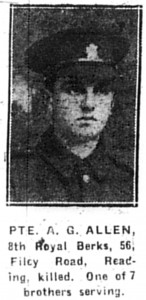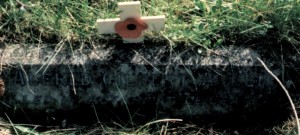Edgar Sidney Smith
Private G/8052 6th Battalion
The Queen’s (Royal West Surrey Regiment)
Division 2
 |
Edgar Sidney Smith, according to the commemoration on the family grave kerb stones was “Killed in Action” in France on November 30th 1917. However, the CWGC search revealed that the date of death was 20th November 1917. His home address is given as 33, London Road, Reading. Early reports recorded him as missing.
The 20th November 1917, heralded the surprise British Advance on Cambrai. The 3rd Army under the command of Lt.-General Byng, attacked along a 10mile front, between St. Quentin and the River Scarpe. The “Hindenburg Line” was broken and numerous villages and over 8,000 German prisoners were captured. The outstanding feature of this advance on Cambrai was that it was not preceded by any preliminary bombardment, the British relied entirely on the use of tanks to break down the dense masses of the enemy’s wire. Though the extreme limits of the attack were Epehy and Fountaine, places some thirty miles apart, the main attack was concentrated on the front between the Bapaume-Cambrai and P¾ronne roads. Having quietly accumulated a large number of tanks in this section, at the pre-arranged moment early in the morning these moved forward, the infantry following in their wake. The novelty and daring of the manoeuvre took the Germans by surprise, and the “Hindenburg line,” considered by them as impregnable, was swiftly penetrated to a depth of several miles by the British.
In the ten days after the initial attack the British consolidated along the front with particularly severe fighting taking place around the village and wood of Bourlon. There was a strong German counter attack on the 25th November and heavy shelling of the wood on the 28th November. The 30th November brought a successful German counterattack which penetrated British positions and Bourlon Wood was eventually evacuated by the British on the 4th December. The Battle of Cambrai officially ended on 7th December 1917.
Edgar Smith is commemorated on the Cambrai Memorial to the Missing, panel 3. The inscription on the Memorial states:
TO THE GLORY OF GOD AND TO THE ENDURING MEMORY OF 7048 OFFICERS AND MEN OF THE FORCES OF THE BRITISH EMPIRE WHO FELL AT THE BATTLE OF CAMBRAI BETWEEN THE 20TH NOVEMBER AND THE 3RD DECEMBER 1917, WHOSE NAMES ARE HERE RECORDED BUT TO WHOM THE FORTUNES OF WAR DENIED THE KNOWN AND HOUNOURED BURIAL GIVEN TO THEIR COMRADES IN DEATH.

